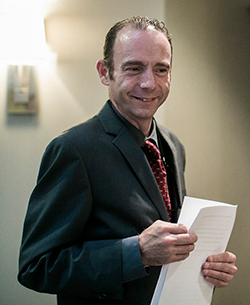 Dr. Nathan CumminsAn HIV-positive bone marrow transplant recipient experienced viral remission for nearly 10 months — 288 days — after stopping antiretroviral therapy (ART), according to a report presented at the Conference on Retroviruses and Opportunistic Infections (CROI) last month.
Dr. Nathan CumminsAn HIV-positive bone marrow transplant recipient experienced viral remission for nearly 10 months — 288 days — after stopping antiretroviral therapy (ART), according to a report presented at the Conference on Retroviruses and Opportunistic Infections (CROI) last month.
Timothy Ray Brown, known as the “Berlin patient,” is the only person known to have been cured of HIV. Diagnosed with leukemia, he stopped ART after a stem cell transplant from a donor with a rare genetic mutation (CCR5-delta-32) that rendered his immune cells resistant to HIV infection. A decade later, Brown remains free of the virus. It is unclear whether his sustained remission is the result of the donor’s mutation, the strong chemotherapy regimen, or other factors.
Several years ago, amfAR-funded grantee Dr. Timothy Henrich reported on the “Boston patients,” two HIV-positive men who — unlike Brown — received bone-marrow transplants with cells that were not resistant to HIV. Both seemed to be free of the virus after stopping ART but experienced viral rebound at three and eight months later.
“Blood stem cell transplantation in the setting of HIV is associated with significant reductions in HIV reservoir size by multiple measures…”
Presented by Dr. Nathan Cummins of the Mayo Clinic in Rochester, Minnesota, and colleagues, this study involved a 55-year-old man who was diagnosed with HIV in 1990 and started ART in 1999 when his CD4 T-cell count was 300 (CD4 cells are white blood cells that fight infection: a normal range is between 500 and 1,500).
In April 2013, the man was diagnosed with leukemia. He began a mild conditioning regimen in advance of a stem cell transplant from a donor who had no CCR5 mutation. At the time, he had a CD4 T-cell count of 288 and an HIV viral load that was almost undetectable at 25 copies/mL. (Viral load describes the amount of HIV in the blood; undetectable is usually defined as fewer than 20 copies/mL.) He developed mild GvHD (graft-versus-host disease), which also occurred in the “Berlin Patient.” Some scientists believe GvHD aided in the Berlin patient’s cure.
 Timothy Ray BrownThe patient continued on ART for more than two years, mostly with an undetectable viral load in the blood and colon. Measurements of reservoir persistence, including HIV DNA, RNA in the blood, a viral outgrowth assay, and RNA in a colon biopsy, suggested a progressively decreasing reservoir during the post-transplant period. In addition, his anti-HIV antibody levels decreased, possibly suggesting a decay in antigen levels.
Timothy Ray BrownThe patient continued on ART for more than two years, mostly with an undetectable viral load in the blood and colon. Measurements of reservoir persistence, including HIV DNA, RNA in the blood, a viral outgrowth assay, and RNA in a colon biopsy, suggested a progressively decreasing reservoir during the post-transplant period. In addition, his anti-HIV antibody levels decreased, possibly suggesting a decay in antigen levels.
At day 784 post-transplant, the patient was carefully taken off ART. His viral levels were tested weekly for the first eight weeks, then monthly. At day 288 — 9.6 months later — he experienced a low-level viral rebound to 60 copies/mL.
Five days later, his level had risen to 1640 copies/mL, requiring that he restart treatment. He had no evidence of drug resistance and his viral load was resuppressed within a month. Interestingly, at day 142 after transplant, the researchers had detected identical clones of virus, suggesting some persistence of the reservoir by normal cell division of infected cells. The researchers theorized that the inflammatory environment caused by his GvHD, during a time when his anti-HIV immune responses were weak, may have allowed this small fraction of the reservoir to persist.
They concluded: “. . . blood stem cell transplantation in the setting of HIV is associated with significant reductions in HIV reservoir size by multiple measures, including prolonged combination of ART-free remission.”
Further analyses are underway to identify what caused the delayed HIV rebound.